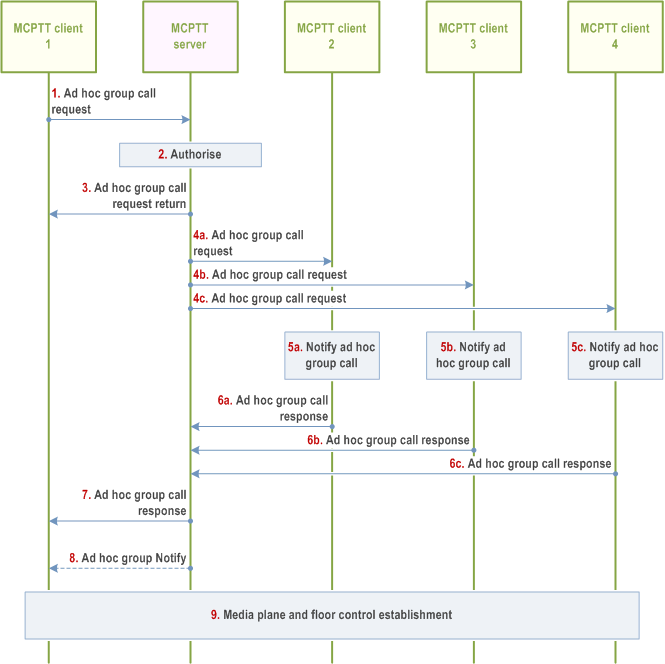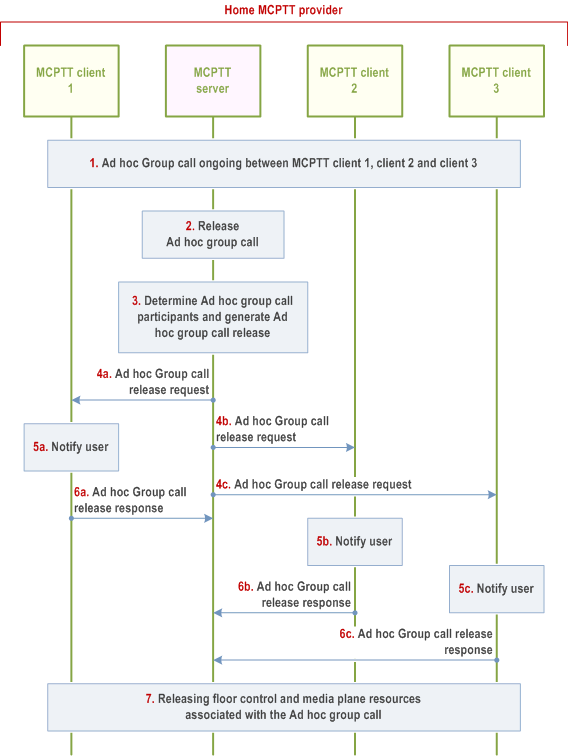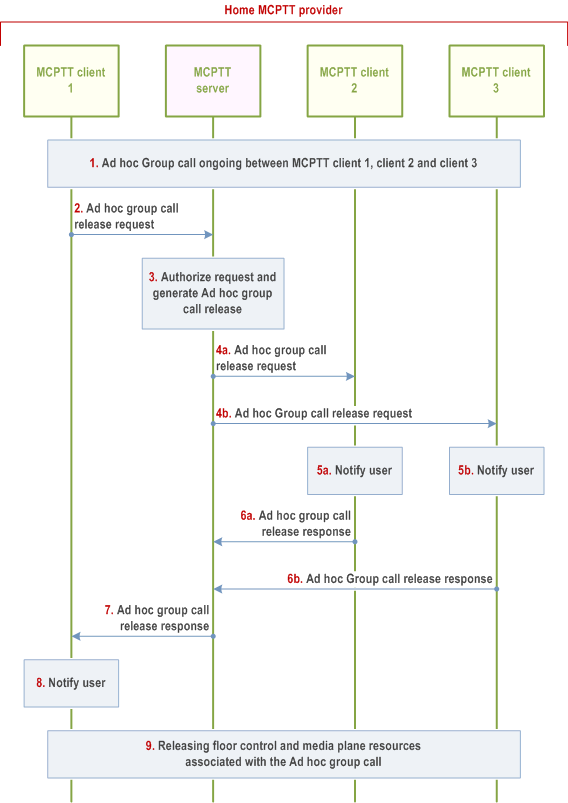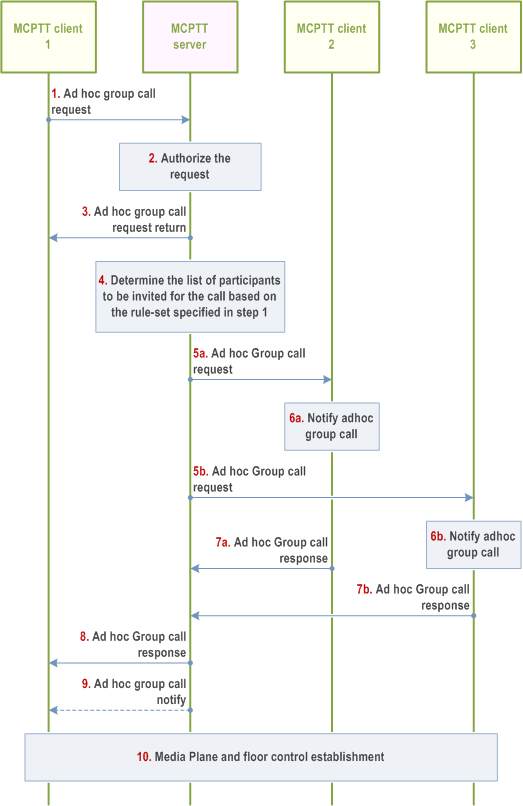Content for TS 23.379 Word version: 19.2.0
1…
7…
7.4…
10…
10.5…
10.6…
10.6.2.2.13…
10.6.2.2.24…
10.6.2.3…
10.6.2.3.1.2…
10.6.2.3.2…
10.6.2.4…
10.6.2.4.3…
10.6.2.5…
10.6.2.5.2.3…
10.6.2.6…
10.6.2.6.2…
10.6.2.7…
10.6.2.10…
10.6.3…
10.7…
10.7.2.2…
10.7.2.3…
10.7.3…
10.7.4…
10.7.5…
10.7.5.2.3a…
10.7.6…
10.7.6.2.3…
10.9…
10.9.1.3…
10.9.1.3.2…
10.9.1.3.3…
10.9.1.4…
10.9.1.5…
10.9.2…
10.9.2.6…
10.10…
10.12…
10.14…
10.15…
10.19…
10.19.2.11…
10.19.3…
10.19.3.1.4…
10.19.3.2…
10.19.3.2.4…
10.19.3.2.6…
A…
A.4…
B…
10.19.3 Procedures
10.19.3.1 Ad hoc group call procedures in single MCPTT system
10.19.3.1.1 Ad hoc group call setup
10.19.3.1.2 Release ad hoc group call
10.19.3.1.2a Release ad hoc group call by an authorized user
10.19.3.1.3 Ad hoc group call setup with MCPTT server determining the participants lists
...
...
10.19.3 Procedures p. 235
10.19.3.1 Ad hoc group call procedures in single MCPTT system p. 235
10.19.3.1.1 Ad hoc group call setup p. 235
Figure 10.19.3.1.1-1 below illustrates the ad hoc group call setup procedure initiated by an authorized user.
Pre-conditions:
- The authorized user at MCPTT client 1 wants to invite MCPTT users at MCPTT client 2, MCPTT client 3 and MCPTT client 4 for the ad hoc group call and is aware of the MCPTT IDs of the participants or to invite the ad hoc group member if the ad hoc group call follows an ad hoc group emergency alert, the MCPTT client 1 is aware of the ad hoc group ID.
- Number of participants being invited for the ad hoc group call is within the limit.
- End-to-End encryption is supported for this ad hoc group call.
- The pre-configured group identity and pre-configured group configuration to be used for an ad hoc group have been preconfigured in MCPTT client and other participants of ad hoc group have also received the relevant security related information to allow them to communicate in an ad hoc group communication.

Step 1.
User at MCPTT client 1 would like to initiate an ad hoc group call. The MCPTT client 1 initiates the ad hoc group call by sending the ad hoc group call request containing the list of participants or an ad hoc group ID from an ad hoc group emergency alert to the MCPTT server. Encryption supported information element shall be set to true since end-to-end encryption is supported. An SDP offer containing the MCPTT client media parameters is included. If there is a floor request to transmit, then the ad hoc group call request contains an indication of an implicit floor request. If the MCPTT user of MCPTT client 1 has selected a functional alias, then the ad hoc group call request contains that functional alias. If the ad hoc group call request contains an implicit floor request it may also include location information.
If the MCPTT user at MCPTT client 1 initiates an MCPTT emergency ad hoc group call or the MCPTT emergency state is already set for the MCPTT client 1 (due to a previously triggered MCPTT emergency alert):
Step 2.
- the MCPTT ad hoc group call request shall contain an emergency indicator;
- if the MCPTT emergency state is not set already, MCPTT client 1 sets its MCPTT emergency state. The MCPTT emergency state of MCPTT client 1 is retained until explicitly cancelled by the user of MCPTT client 1.
If the ad hoc group call is supported, the MCPTT server verifies whether the user at MCPTT client 1 is authorized to initiate an ad hoc group call. If not authorized, the MCPTT server rejects the ad hoc group call request as specified in the step 3. The MCPTT server accepts the ad hoc group call request if the ad hoc group call is supported and authorized. If authorised, it validates whether the number of invited participants is within the configured limit before proceeding with the call setup.
If functional alias is present, the MCPTT server checks whether the provided functional alias allowed to be used and has been activated for the user.
If location information was included in the ad hoc group call request, the MCPTT server checks the privacy policy of the MCPTT user to decide if the location information of MCPTT client 1 can be provided to other users on the call (refer to Annex A.3 "Authorisation to provide location information to other MCPTT users on a call when talking").
If an emergency indicator is present in the received MCPTT ad hoc group call request, the MCPTT ad hoc group is considered to be in the in-progress emergency state until this ad hoc group call is terminated; and
If an imminent peril indicator is present in the received MCPTT ad hoc group call request, the MCPTT ad hoc group is considered to be in the in-progress imminent peril state until this ad hoc group call is terminated.
If the MC service users' information received in step 1 does not contain an ad hoc group ID from an ad hoc group emergency alert, the MCPTT server forms the ad hoc group by using MCPTT users' information received in step 1, determines the preconfigured group to be used for the configuration of the ad hoc group and assigns a MC service group ID for the newly formed ad hoc group. If no MC service ad hoc group ID was included in the ad hoc group call request of step 1, or if the provided MC service ad hoc group ID is not accepted by the MC service server, the MCPTT server assigns a MCPTT group ID for the newly formed ad hoc group.
The MCPTT server considers the ad hoc group call participants as implicitly affiliated to the ad hoc group.
Step 3.
The MCPTT server shall send the ad hoc group call request return message to MCPTT client 1 containing the below:
Step 4a-4c.
- The MCPTT ad hoc group ID either generated by the MCPTT server or provided by the MCPTT client 1 if the ad hoc group ID is from an ad hoc group emergency alert (only included when the ad hoc group call is authorized);
- The group ID of the pre-configured group to be used for the ad hoc group call (only included when the ad hoc group call is authorized); and
- Result of whether the ad hoc group call is authorized or not.
The MCPTT server sends the ad hoc group call requests towards the MCPTT clients of the invited users based on step 1. While sending the ad hoc group call requests, the MCPTT server shall remove the information elements that are not required to be conveyed to the target MCPTT clients (e.g. MCPTT ID list of the users who are required to acknowledge)
Step 5a-5c.
The receiving MCPTT clients notify their corresponding MCPTT user about the incoming ad hoc group call request with the information of the MCPTT group ID for the ad hoc group.
Step 6a-6c.
The receiving MCPTT clients may accept or reject the ad hoc group call requests and send ad hoc group call responses to the MCPTT server. The response may also contain a functional alias of the responding MCPTT user, which is verified (valid and activated for the user) by the MCPTT server.
Step 7.
The MCPTT server sends the ad hoc group call response to MCPTT client 1 through the signalling path to inform about successful call establishment.
Step 8.
If the initiating MCPTT user requires the acknowledgement from the invited MCPTT users, and the required MCPTT users do not acknowledge the call setup within a configured time (the "acknowledged call setup timeout"), then the MCPTT server may proceed with or abandon the call and then notify the initiating MCPTT user that the acknowledgements did not include all required members according to ad hoc group call policy from the user profile configuration. The MCPTT server may notify the initiating MCPTT user of all MCPTT users who did not acknowledge the ad hoc group call request within the configured time. This notification may be sent to the initiating MCPTT user by the MCPTT server more than once during the call when MCPTT users join or leave the MCPTT ad hoc group call.
Step 9.
MCPTT client 1, MCPTT client 2, MCPTT client 3 and MCPTT client 4 establish media plane and floor control resources.
10.19.3.1.2 Release ad hoc group call p. 238
The procedure focuses on the case where the MCPTT server releases an ongoing MCPTT ad hoc group call for all the participants of that ad hoc group call, since at least one of the release conditions are met e.g., due to hang time expiry, last participant leaving, second last participant leaving, initiator leaving.
Figure 10.19.3.1.2-1 below illustrates the signalling control plane procedure for the MCPTT server initiating termination an ongoing ad hoc group call.

Step 1.
It is assumed that MCPTT users on MCPTT client 1, client 2 and client 3 are already part of the ongoing ad hoc group call.
Step 2.
MCPTT server would like to release the MCPTT ad hoc group call which is ongoing e.g., due to hang time expiry, last participant leaving, second last participant leaving, initiator leaving.
Step 3.
MCPTT server identifies the participants of the ongoing ad hoc group call and generates ad hoc group call release request to release ongoing session. The MCPTT server cancels the in-progress emergency state or in-progress imminent peril state of the ad hoc group if the ad hoc group call is an emergency or imminent peril call respectively.
Step 4.
MCPTT server sends ad hoc group call release request via SIP core towards each participant of the ongoing ad hoc group call.
Step 5.
MCPTT users are notified about the release of the ad hoc group call.
Step 6.
MCPTT client(s) receiving ad hoc group call release request, acknowledge towards the MCPTT server by sending an ad hoc group call release response.
Step 7.
MCPTT client 1, client 2 and client 3 have successfully released the floor control and media plane resources associated with the ad hoc group call that is terminated and the ad hoc group ceases to exist (i.e., further call is not possible over the same ad hoc group, otherwise if the ad hoc group call follows an ad hoc group emergency alert the ad hoc group continues to exist (i.e., further calls over the same ad hoc group are possible).
10.19.3.1.2a Release ad hoc group call by an authorized user |R19| p. 239
The procedure focuses on the case where an authorized user releases an ongoing MCPTT ad hoc group call for all the participants of that ad hoc group call.
Figure 10.19.3.1.2a-1 below illustrates the signalling control plane procedure for the MCPTT client initiating termination of an ongoing ad hoc group call.

Step 1.
It is assumed that MCPTT users on MCPTT client 1, client 2 and client 3 are already part of the ongoing ad hoc group call.
Step 2.
The authorized MCPTT user on MCPTT client 1 would like to release the MCPTT ad hoc group call which is ongoing and sends an ad hoc group call release request to the MCPTT server.
Step 3.
MCPTT server checks whether the MCPTT user on MCPTT client 1 is authorized to release the ad hoc group call and generates ad hoc group call release request to release ongoing session. The MCPTT server cancels the in-progress emergency state or in-progress imminent peril state of the ad hoc group if the ad hoc group call is an emergency or imminent peril call respectively.
Step 4.
The MCPTT server sends ad hoc group call release request via SIP core towards MCPTT client 2 and MCPTT client 3.
Step 5.
MCPTT users on MCPTT client 2 and MCPTT client 3 are notified about the release of the ad hoc group call.
Step 6.
MCPTT client 2 and MCPTT client 3 acknowledge the ad hoc group call release request towards the MCPTT server by sending an ad hoc group call release response.
Step 7.
The MCPTT server sends ad hoc group call release response to MCPTT client 1.
Step 8.
MCPTT user on MCPTT client 1 is notified about the release of the ad hoc group call.
Step 9.
MCPTT client 1, client 2 and client 3 have successfully released the floor control and media plane resources associated with the ad hoc group call that is terminated and the ad hoc group ceases to exist (i.e., further call is not possible over the same ad hoc group, otherwise if the ad hoc group call follows an ad hoc group emergency alert the ad hoc group continues to exist (i.e., further calls over the same ad hoc group are possible).
10.19.3.1.3 Ad hoc group call setup with MCPTT server determining the participants lists p. 240
Figure 10.19.3.1.3-1 below illustrates the ad hoc group call setup procedure initiated by the MCPTT user and MCPTT client 1 wherein the list of participants is determined by the MCPTT server based on the citeria received from the MCPTT client.
Pre-conditions:
- The MCPTT user at MCPTT client 1 is authorized to initate ad hoc group call.
- The MCPTT user at MCPTT client 1 wants to invite MCPTT users who are satisying certain criteria for the ad hoc group call.

Step 1.
User at MCPTT client 1 would like to initiate an ad hoc group call in-order to invite the participants satisfying specific criteria. The MCPTT client 1 initiates the ad hoc group call by sending the ad hoc group call request containing the details of the criteria to be applied by the MCPTT server for determining the participant list. If end-to-end encryption is supported, the Encryption supported information element shall be set to true and pre-configured MCPTT group whose configuration is to be applied is included. An SDP offer containing the MCPTT client media parameters is included. If there is a floor request to transmit, then the ad hoc group call request contains an indication of an implicit floor request. If the MCPTT user of MCPTT client 1 has selected a functional alias, then the ad hoc group call request contains that functional alias. If the ad hoc group call request contains an implicit floor request it may also include location information.
If the MCPTT user at MCPTT client 1 initiates an MCPTT emergency ad hoc group call or the MCPTT emergency state is already set for the MCPTT client 1 (due to a previously triggered MCPTT emergency alert):
Step 2.
- the MCPTT ad hoc group call request shall contain an emergency indicator;
- if the MCPTT emergency state is not set already, MCPTT client 1 sets its MCPTT emergency state. The MCPTT emergency state of MCPTT client 1 is retained until explicitly cancelled by the user of MCPTT client 1.
If the ad hoc group call is supported, the MCPTT server verifies whether the user at MCPTT client 1 is authorized to initiate an ad hoc group call. If not authorized, the MCPTT server rejects the ad hoc group call request as specified in the step 3. The MCPTT server accepts the ad hoc group call request if the ad hoc group call is supported and authorized.
If functional alias is present, the MCPTT server checks whether the provided functional alias is allowed to be used and has been activated for the user.
If location information was included in the ad hoc group call request, the MCPTT server checks the privacy policy of the MCPTT user to decide if the location information of MCPTT client 1 can be provided to other users on the call (refer to Annex A.3 "Authorisation to provide location information to other MCPTT users on a call when talking").
If an emergency indicator is present in the received MCPTT ad hoc group call request, the MCPTT ad hoc group is considered to be in the in-progress emergency state until this ad hoc group call is terminated; and
If an imminent peril indicator is present in the received MCPTT ad hoc group call request, the MCPTT ad hoc group is considered to be in the in-progress imminent peril state until this ad hoc group call is terminated.
If the information received in the request in step 1 does not contain an ad hoc group ID from an ad hoc group emergency alert, the MCPTT server forms the ad hoc group by using received information, and determines the preconfigured group to be used for the configuration of the ad hoc group. The MCPTT server assigns a MCPTT group ID for the newly formed ad hoc group. Further, the ad hoc group participants are included to ad hoc group once determined as specified in the step 4.
Step 3.
The MCPTT server shall send the ad hoc group call request return message to MCPTT client 1 containing the below:
Step 4.
- The MCPTT ad hoc group ID, either generated by the MCPTT server, if not included in the ad hoc group call request of step 1, or if the provided MCPTT ad hoc group ID is not accepted by the MCPTT server, or provided by the MCVideo client 1 if the ad hoc group ID is from an ad hoc group emergency alert;
- The group ID of the pre-configured group to be used for the ad hoc group communication (only included when the ad hoc group data session is authorized); and
- Result of whether the ad hoc group call is authorized or not
The MCPTT server determines the list of participants to be invited for the ad hoc group call based on the information present in the information element Criteria for determining the participants. This information element could carry either criteria or indicator identifying pre-defined criteria or a combination of both.
Step 5.
The MCPTT server sends the ad hoc group call requests towards the MCPTT clients 2 and 3. While sending the ad hoc group call requests, the MCPTT server shall remove the information elements that are not required to be conveyed to the target MCPTT clients. This request carries the pre-configured group ID whose configuration is to be applied for this ad hoc group call if end-to-end encryption is requested. The MCPTT server considers the ad hoc group call participants as implicitly affiliated to the ad hoc group.
Step 6.
The receiving MCPTT clients notify their corresponding MCPTT user about the incoming ad hoc group call request with the information of the MCPTT group ID for the ad hoc group.
Step 7.
The receiving MCPTT clients may accept or reject the ad hoc group call requests and send ad hoc group call responses to the MCPTT server. The response may also contain a functional alias of the responding MCPTT user, which is verified (valid and activated for the user) by the MCPTT server.
Step 8.
The MCPTT server sends the ad hoc group call response to MCPTT client 1 through the signalling path to inform about successful call establishment.
Step 9.
The MCPTT server may notify the initiating MCPTT user of all MCPTT users who acknowledged the ad hoc group call request and joined the ad hoc group call. This notification may be sent to the initiating MCPTT user by the MCPTT server more than once during the call when MCPTT users join or leave the MCPTT ad hoc group call. The authorized users (not shown in figure), who are configured to receive the participants information of ad hoc group call, are notified to receive the MCPTT IDs of the MCPTT users who acknowledged the ad hoc group call request and joined the ad hoc group call, when the MCPTT users joins late or leave the MCPTT ad hoc group call.
Step 10.
MCPTT client 1, MCPTT client 2 and MCPTT client 3 establish media plane and floor control resources.